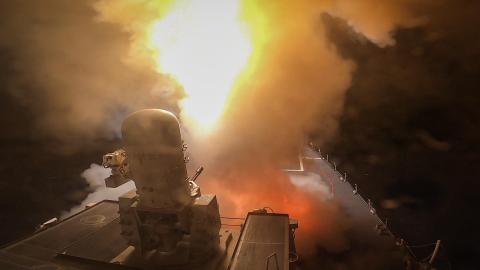Three Things about the Israel-Hamas War is a new series from the Hudson Center for Peace and Security in the Middle East. Every week, Hudson Senior Fellows Michael Doran, Can Kasapoğlu, and Jonathan Schachter will each offer an analysis of one thing—and one thing only—that is of particular importance to understand the Israel-Hamas war. Subscribe here.
Read their analysis below.
Iran and Hezbollah blinked.
With his speech last Friday, Hassan Nasrallah, the secretary general of Hezbollah, disappointed Hamas and its supporters by revealing no immediate intention to escalate Hezbollah’s attacks on Israel along its northern border with Lebanon. In the weeks after October 7, as Israel bombed Gaza from the air in preparation for its subsequent ground incursion, Iranian officials seemed to promise that, if Israel were to enter Gaza on the ground, Hezbollah would join the fray with greater gusto than it has so far displayed.
“I know about the scenarios that Hezbollah has put in place,” Iranian Foreign Minister Hossein Amir-Abdollahian said on October 14 after meeting with Nasrallah. “Any step the resistance [Hezbollah] will take will cause a huge earthquake in the Zionist entity.”
But no earthquake has occurred, and if Nasrallah’s speech is anything to go by, there probably will not be one. While he kept his options open—stating that Hezbollah was prepared for any eventuality—he also seemed comfortable in a secondary, supporting role.
“Our battle has not reached the stage of victory by knockout,” Nasrallah said, in words addressed directly to the Palestinians. Victory, he explained, will come “with steadfastness, patience, and the ability to endure. This is what the enemy does not have.”
This emphasis on wearing down the enemy slowly was good news for Israel. When the war first broke out on October 7, Prime Minister Benjamin Netanyahu feared that Iran had thrown a jab from Gaza to set Israel up for an uppercut from Hezbollah, which is far more powerful than Hamas. Perhaps, as many analysts are saying, the deployment of American forces to the Middle East, along with the massive mobilization of the Israeli army, has deterred both Iran and Hezbollah. Or perhaps Iran never had a plan to throw any one-two punches.
Whatever the case, Nasrallah’s speech made clear that he, and presumably his overlords in Tehran, regard military pressure on the United States, not on Israel itself, as the surest way to stop the fighting.
— Michael Doran
Iran is anti-Israel, not pro-Palestine.
In the war in Gaza, Hamas has captured the headlines. But Palestinian Islamic Jihad also deserves attention—especially its armed wing, the Saraya al-Quds.The Saraya played a critical role in the October 7 attacks, particularly in the raid on the Israeli military base near Nahal Oz. In that assault it used weapons acquired from Iran, including anti-materiel rifles, rockets, drones, and rocket-propelled grenades equipped with tandem-charge warheads that can pierce armor.
Since the Saraya is under the direct command and control of Iran’s Quds Force, observing its behavior illuminates the role Iran seeks in the unfolding conflict.
The Saraya’s actions reveal that its puppet masters in Tehran are not attempting to protect or defend the Palestinians, but are simply looking to destroy Israel. Any thorough assessment of the geopolitics of the Gaza conflict needs to begin with the understanding that Iran desires only to be lord of the rubble.
This complicates the relationship between Palestinian Islamic Jihad and Hamas—the two organizations are, at best, frenemies. Sometimes they cooperate, but sometimes Iran and its proxies drag Hamas into conflicts with Israel that it does not want. Tolerating the volatility of Palestinian Islamic Jihad is part of the price Hamas pays for Iranian support.
Yet the Saraya does not have a conventional stake in Palestinian politics. Its raison d’être is to promote strife. If Hamas becomes too quiet for too long, the Saraya will stoke conflict with Israel, helping to ensure that Iran will always put its interests before those of the Palestinians whom it claims to champion.
— Can Kasapoǧlu
The United States is suffering from a deterrence gap of its own making in the Middle East.
In March of this year, Secretary of Defense Lloyd Austin told the Senate that Iran or its proxies had attacked American positions in Iraq and Syria 83 times since January 2021, and that the United States had responded with force only four times.
Now the administration is trying to deter Hezbollah and Iran from joining the fight between Israel and Hamas. Washington has deployed two carrier battle groups to the region and has passed public and private messages to Tehran, urging the Islamic Republic to hold its fire. But after almost three years of unwavering risk aversion, the US deterrent threat has been severely weakened.
The results of this miscalculation speak for themselves. Though not fully engaged, Hezbollah has initiated a low-intensity shooting war across Israel’s northern border. Iran’s Houthi proxies in Yemen have fired ballistic and cruise missiles and drones at Israel (which have been intercepted by the United States, Israel, and, reportedly, Saudi Arabia). And Iran’s other proxies have intensified their attacks on US bases in Iraq and Syria. Iran continues to test and pressure the Biden administration.
The American reply? On October 27, after no fewer than 20 attacks on its positions in the region since October 17, the US struck Iranian proxies in Syria. The effect of this attempt at deterrence seems to have been no more potent than it was in 2021, as Iran has hit American targets at least 18 more times since the US strike. According to the Pentagon, at least 45 Americans have been injured in these attacks. The US has set the worthy goal of keeping the war from expanding, but rather than sending a consistent and strong deterrent message to meet that goal, Washington has projected fear of escalation.
The White House has the formula for deterrence backward. Until the US demonstrates that it is willing to escalate and exact costs from Iran for its aggression, Tehran and its terrorist proxies will continue to attack US forces and Israel, and possibly expand the scope and scale of the war in Gaza—the exact outcome the administration is trying to avoid.
— Jonathan Schachter




















